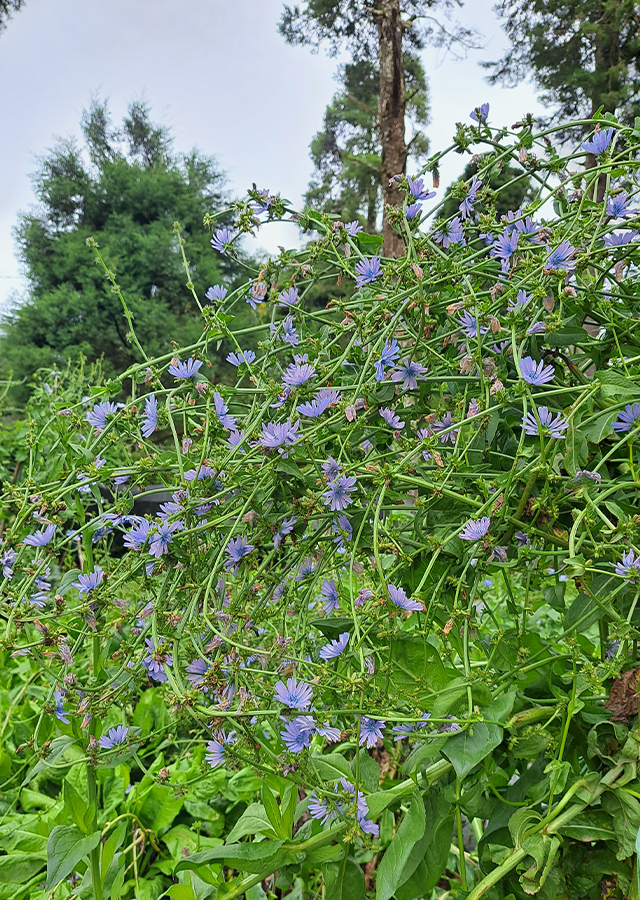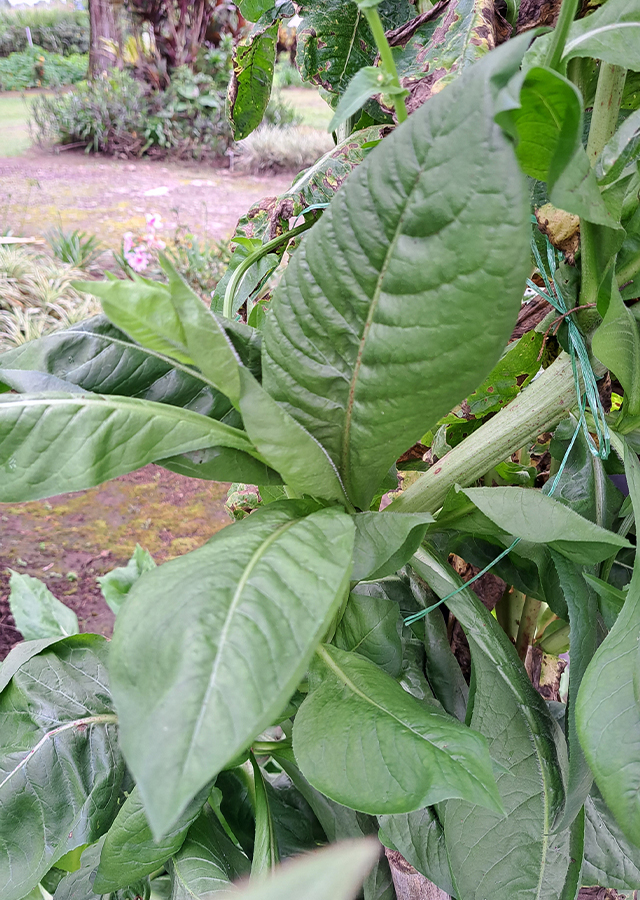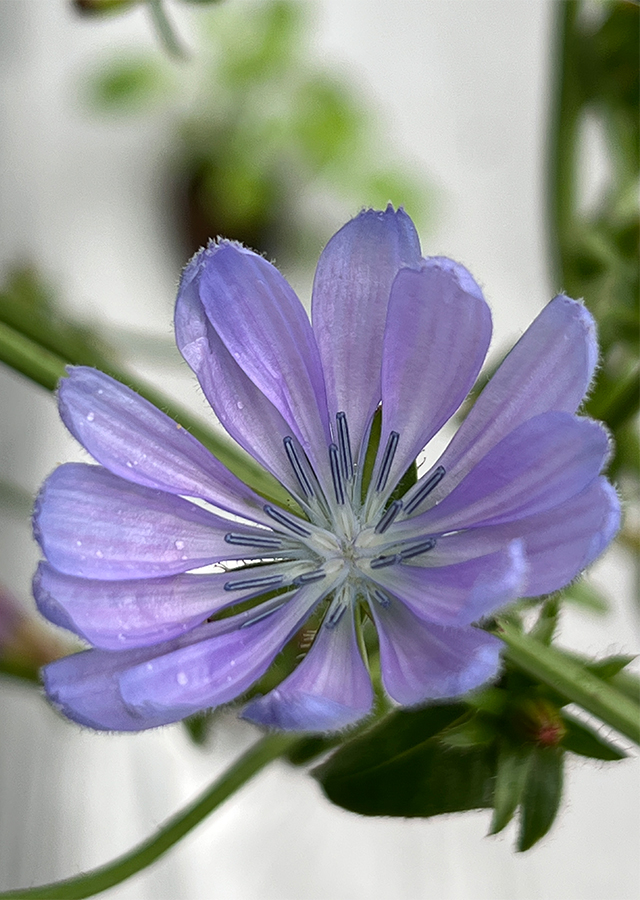Chicory
Cichorium intybus L.
Asteraceae
Location in our garden
Principal



Synonym
Cichorium endivia var. sativum DC.
Cichorium intybus var. balearicum (Porta) Gand.
Cichorium intybus var. sylvestre (Garsault) Vis.
Habitus
Herbaceous. A perennial herb growing up to 1.5 m tall.
Part Used
Leaves
Flowers
Roots
The Whole Plant
Growing Requirements
Full Sunshine
Habitat
Grassland
Terrestrial
Overview
Cichorium intybus is native to Europe, western Asia and Central Russia, then introduced (cultivated and wild), mainly in temperate regions. The bitter leaves are a favourite vegetable in Europe but not very well known in South-East Asia. It is normally grown for its leaves, buds, and roots as it consists of certain valuable qualities. In terms of nutritive value, chicory is a great source of vitamins and minerals, including zinc, magnesium, manganese, calcium, iron folic acid, and potassium, as well as vitamins A, B1, B2, B3, B5, B6 and C. A red-leaved variety and flower are used in salads, also occasionally in South-East Asia. A blue dye has been obtained from the leaves. The root can serve as a substitute for coffee.
Vernacular Names
Chicorée witloof (French), Diếp xoăn.(Vietnamese).
Agroecology
Chicory grows on any type of soil but, when cultivated, grows best on mellow, deeply tilled, fertile soil or sandy loam. Prefers a sunny position in any moderately fertile well-drained moisture retentive soil, with a pH 5.5 to 7. Tolerates a pH in the range 4.5 to 8.3, with an annual rainfall of 30 to 400 cm and an annual mean biotemperature of 6° to 27 °C. A cool weather crop, it tolerates only moderate summer temperatures and requires well-distributed rainfall, with good drainage, or some irrigation in drier areas.
Morphology
- Roots - long, single, thick, strong, well developed spindle-shaped taproot.
- Stems - erect, hollow, round, nearly leafless, green to reddish brown stems that produce a milky sap once cut. Lower part of stems is hairy.
- Leaves - stalked, lanceolate and unlobed. Two types of leaves: Rosette leaves and Lance-shaped stem leaves. Rosette leaves are normally 5.1-15 cm long, oblong with rough hairs on upper and lower surfaces. Margins are shallowly toothed or deeply dissected. Lance-shaped stem leaves are usually small, sparse, alternate, and clasping with margins either smooth or slightly toothed. Chicory leaves are mildly bitter flavour and bitter in taste.
- Flower - heads are 2 to 4 cm wide and usually bright blue, rarely white or pink. There are two rows of involucral bracts – the inner one is longer and erect and outer is shorter and spreading. Each flower lasts only one day. It blooms in the morning and close later in the day.
- Witloof - lanceolate in shape, with the length ranging from 2 to 3 times the maximum width,milky-white appearance and a light yellow tinge, slightly bitter.
- Fruit - about 0.3 cm long, dark brown and wedge shaped. Fruit consists of one seed. Each plant produces as many as 3000 seeds.
- Seeds - miniature, obovate-shaped seed which are light brown colored.
Cultivation
- Generatively propagated by seed.
- Sow the wild form or cultivars being grown for their roots in May or June in situ. Cultivars being grown for their edible leaves can be sown in April for a summer crop or in June/July for a winter crop. Sow them in situ or in pots and then plant them out as soon as they are large enough.
Chemical Constituents
Amino acids (tryptophan, threonine, isoleucine, leucine, and lysine), polyphenols, inulin (starch-like polysaccharide), coumarins, flavonoids, sesquiterpene lactones (lactucin and lactucopicrin), tannins, alkaloids, volatile oils.
Traditional Medicinal Uses
- The root and the leaves are appetizer, cholagogue, depurative, digestive, diuretic, hypoglycaemic, laxative and tonic.
- Root has traditionally been used in tea or in medicinal remedies to cure liver enlargement, jaundice, rheumatism and gout.
- Root extracts can relieve stress and anxiety, and can also help reduce your chances of cognitive decline, heart disease, insomnia, hormonal imbalance, and premature aging.
- A decoction of the freshly harvested plant is used for treating gravel.
- Chicory extracts have anti-tumor qualities and antioxidant properties, and antioxidant, anticancer, anti-inflammatory, antiparasitic, antihepatotoxic properties.
Part Used
Reference Sources
- Health Benefit Times. (2021). Chicory – Cichorium intybus. https://www.healthbenefitstimes.com/chicory/. 08-01-2023.
- Kew Royal Botanic Garden. (No date). Plants of the World Online: Cichorium intybus L. https://powo.science.kew.org/taxon/urn:lsid:ipni.org:names:194533-1#synonyms. 08-01-2023.
- Nwafor, I. C., Shale, K., and Achilonu, M. C. (2017). Chemical Composition and Nutritive Benefits of Chicory (Cichorium intybus) as an Ideal Complementary and/or Alternative Livestock Feed Supplement. THe Scientific World Journal, Volume 2017 | Article ID 7343928 | https://doi.org/10.1155/2017/7343928.
- Plant Resources of South-East Asia. (2016). Cichorium intybus (PROSEA). https://uses.plantnet-project.org/en/Cichorium_intybus_(PROSEA). 08-01-2023.
- Plants For A Future. (2023). Cichorium intybus - L. https://pfaf.org/user/plant.aspx?LatinName=Cichorium+intybus. 08-01-2023.

